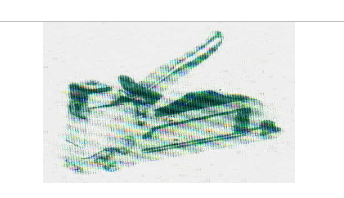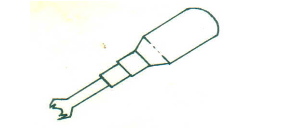Lesson 5: Stuffing Equipments
Introduction
Dear learner l welcome you to another section on the tools and equipments used in the upholstery industry. In this section I shall discuss the tools used for stuffing the upholstery furniture.
|
At the end of this section you will be able to:
|
Stuffing rod
The stuffing rod, Fig 5.1 which is also called stuffing iron is made of steel. It length is about 45cm long. It is used to force padded materials into corners that are difficult to reach by hand.
Fig 5.1 Stuffing rod
Upholsterer’s pins or skewers The upholsterer’s pin, Fig 5.2a is used to hold fabric in place whilst it is sewed, tacked or stapled. It is a short wire with length ranging from 8cm to 9cm. One end of the upholsterer’s pin is pointed and the other end has a loop. There is also a lightweight pin, which is used for the same purpose called the T-pin. fig 5.2b
a b
Fig 5.2 Pins for upholstery
Staplers To install an upholstery material one can use either tacking or stapling methods. The stapling is more faster and efficient way of securing fabrics. It also helps to hold fabrics more evenly.
Fig 5.3 Stapling gun
In using the stapling gun for stapling, Fig 5.3 one hand of the upholsterer can be use to operate it whilst the other hand is used to stretch and hold the fabric. For a small shop the spring-loaded stapler or a stapling hammer is most economical to use since the pneumatic or the electric staplers are too expensive and not economical.
Staple puller The staple puller, Fig 5.4, is used to remove staplers from furniture frames. It is used either when installing a new fabric on furniture or when stripping off an old fabric from upholstered furniture. Since it is designed purposely for that function it is able to remove staples easily with less damage to the wood surface than a claw or ripping tool.
Fig 5.4 Staple puller
Bottom covering machines Bottom covering machines are used for covering buttons with fabric Fig 5.5 These machines can be hand operated or power-operated. When using this device to produce upholstery buttons, the machine cut the fabric and forces it into position around the button.
Fig 5.5 Button machine
Cutting table
A cutting table is used for laying out and cutting of fabrics. Since most upholstery fabrics are 137cm wide the table should be at least 1.5m wide and an average length of 2.4m. In using the table it should be placed away from a wall in order to ensure that the upholsterer can walk round it. Usually upholsterers use the space under the table for storage of items.
Trestle
Trestle, Fig 5.6 is a special type of bench, which can be used singly or in pairs to elevate upholstery work to a comfortable height for the upholsterer to work on it. One special feature about this bench is that the top is padded to prevent marring of upholstery fabric and finished woodwork. The top also provides a convenient place to put tools and small equipment while working.
Fig 5.6 Trestle
Sewing machine
Upholsterers in sewing upholstery fabrics also use sewing machine, which is also used by seamstress and fashion designers (Fig 5.7). Although the domestic sewing machines can be used to successfully sew lightweight to medium weight upholstery fabrics most professionals in the trade prefer to use industrial sewing machine, which can be used to sew all kinds of fabrics.
The sewing machine uses different sizes of needle for different fabrics. For example for lightweight to medium weight upholstery fabric it is best to use needle of size 16/100. Also for heavyweight fabric it is most preferable to use needle of size 18/110. There are also specially designed needles for the sewing of leathers. These needles have a wedge-shaped point that cut a tiny slit, rather than a round hole.
Fig 5.7Sewing machine
Needles and accessories To improve upon the efficiency of this machine specially design needles and accessories are used at different stages of the work. A welting foot for instance is very helpful for sewing welts. This accessory has a groove cut at the bottom of the foot, which rides over the cord covered with fabric. Hence feeding the layers of fabric evenly for a smooth, tight fit. A zipper foot accessory is also essential for inserting zippers into cushions. It can also be used as a substitute for the welting foot. The general-purpose foot, which is also called straight stitch foot, can be used for sewing all seams that does not have welting.
Self assessment
1.List four tools that can be used for stufting an upholstered chair 2.Describe the operation of a bottom covering machine 3.Why is the surface of a trestle padded 4.List two accessories that can be used to make the sewing machine more efficient.
Summary Dear learner I hope you have thoroughly gone through this section. In this section I looked at some of the equipments used for stuffing. I discussed the stuffing rod, the upholsterer’s pins or skewers, the stapling gun, the staple puller and others.




